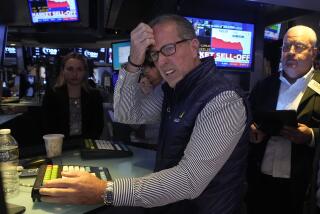The Incredible Shrinking of Growth Stocks
In a stunning reversal of fortune, the greatest consumer growth stocks of the ‘80s are being tossed willy-nilly from the portfolios of investors large and small.
Last week, it was tobacco king Philip Morris. Tuesday it was a host of others, including premier retailer Wal-Mart, hammered down $2 to $27.75 on huge trading volume of 14.6 million shares.
On the surface, this selloff of tobacco, retail, food, cosmetic and other consumer giants is a reaction to the companies’ perceived loss of pricing power in a slow-growth economy.
But the dynamics of the growth stocks’ decline is much more complex, analysts say. In large part, this is market physics at work: What goes up eventually comes down. And what goes up a lot usually comes down a lot.
In that sense, there’s a disturbing parallel between the late-’80s growth-stock boom and that of the “Nifty Fifty” growth-stock period of the late-’60s and early-’70s. Both eras witnessed investors proclaiming a relative handful of growth stocks as “untouchable” franchises that would expand at a fast pace, seemingly forever.
The Nifty Fifty period ended with the horrendous bear market of 1973-74, when the growth promises of many of that era’s stars proved hollow--and the Dow industrials lost more than 40% of their value.
This time, however, most Wall Streeters don’t see the shadow of the bear over the broad market--at least not yet. Ironically, that is one of the growth stocks’ ancillary problems today: Many investors who’ve ridden them all the way up now find more enticing opportunities elsewhere in the market, in such long-ignored sectors as heavy industry, autos and energy.
So selling the growth stocks at the first sign of trouble is an easier decision than it might otherwise be. For now, says Tucker, Anthony technical-market analyst Helene Meisler in New York, “the bear market lives in individual stocks”--the former growth darlings.
*
The current growth selloff began last week with Philip Morris’ decision to slash the prices of its premium cigarettes. Morris shares lost 23% in one day, and the selling fever has since spread to nearly every other major consumer stock group.
The fears are the same all around--that in an era of slow consumer spending and cutthroat competition, the brand-name stars of the ‘80s are vulnerable to severe discounting in order to maintain sales growth. Discounting potentially means lost earnings. The rest is academic.
On Tuesday, Colgate-Palmolive tumbled $2.125 to $60 after losing $2.625 on Monday. Quaker Oats, down $1.375 on Monday, fell $1.625 on Tuesday to $63.375. Even mighty Coca-Cola is down $2 over the two days, to $40. Meanwhile, retailers such as Wal-Mart are being pulled down by the same concerns about consumer spending.
Rather than view this latest selloff as the beginning of a market trend, however, many Wall Streeters say it is just another leg in a growth stock decline that started 15 months ago with a plunge in biotechnology stocks. The major drug stocks soon followed as their earnings growth began to slow in a more competitive health care arena--long before Bill Clinton won the White House and attacked their pricing policies as obscene.
Steven Einhorn, stock strategist at Goldman, Sachs & Co. in New York, doesn’t argue that earnings growth is slowing at consumer-brand companies. But he contends that “many of these consumer companies still will have earnings growth rates above that of the average company,” even after the slowdown.
Whether the consumer stocks deserve to go up or down from here, Einhorn says, “is a question of what their growth rates are slowing to , and do the stocks’ (price-to-earnings) multiples reflect that slowing?”
In Pasadena, money manager Roger Engemann oversees $5 billion for clients, almost all of it invested in classic growth stocks. He is adamant that the declines in most of these issues--Merck, Gillette, Coke, Wal-Mart--”is just a silliness that the market gets into from time to time.”
His typical growth stock, Engemann says, sells for 15 times this year’s expected earnings per share. How on earth, he asks, can someone argue that such stocks are overpriced--or worse, that this is just the start of a replay of the Nifty-Fifty crash of 1973-74?
In 1972, just before that era’s bear market began, the high-flying growth stocks of the day--Avon, Xerox, Kodak and others--carried stratospheric price-to-earnings multiples of 50 to 100, Engemann notes. There is no comparison with the already-clipped multiples of the ‘80s-era growth giants, he says. So he refuses to sell, certain that his stocks will rebound. “We have no hesitation about sticking with this,” Engemann asserts.
*
Yet for the time being and perhaps the rest of 1993, Engemann’s stocks face another source of pressure that ignores the valuation issue: When a group of stocks leads the market for a long period, as the growth stocks did from 1982 through 1991, their owners accumulate massive paper profits.
When those investors sense that the market is turning against their stocks, the urge to exit becomes overwhelming. Given how extensively owned these growth stocks have become, sellers are everywhere--and buyers sense no urgency.
So just as the drug stocks have been falling for 15 months, so too other growth stock giants of the ‘80s may be only a short way into their declines.
“I would never have thought that a biotech stock would become a low price-to-earnings stock, but we’re about there with Amgen,” says David Dreman, a New York money manager who focuses on inexpensive stocks. Does that mean he’s ready to buy falling growth stocks? “We’re just picking very, very slowly,” Dreman says.
Growth Stocks: More Carnage Ahead?
Here’s how some of the major consumer growth stocks of the ‘80s have tumbled so far from their all-time peak prices.
All-time Tues. close Drop, peak Stock high and change to now Philip Morris 86 5/8 48 1/8, -1 3/4 -44% Merck 56 5/8 33 7/8, - 1/4 -40% Bristol-Myers 90 1/8 59, + 3/4 -35% Tambrands 70 1/2 50 3/4, -1 3/4 -28% Kellogg 75 3/8 58, - 7/8 -23% H.J. Heinz 48 5/8 37 1/4, - 1/2 -23% Home Depot 68 5/8 55 5/8, -3 5/8 -19% Wal-Mart 34 1/8 27 3/4, -2 -19% Procter & Gamble 55 3/4 46 3/4, - 5/8 -16% Colgate-Palmol. 67 1/4 60, -2 1/8 -11% Gillette 61 3/8 56 1/2, -1 3/8 -8% S&P; 500 index 456.33 441.16, -1.13 -3%
All trade on NYSE.
More to Read
Inside the business of entertainment
The Wide Shot brings you news, analysis and insights on everything from streaming wars to production — and what it all means for the future.
You may occasionally receive promotional content from the Los Angeles Times.










